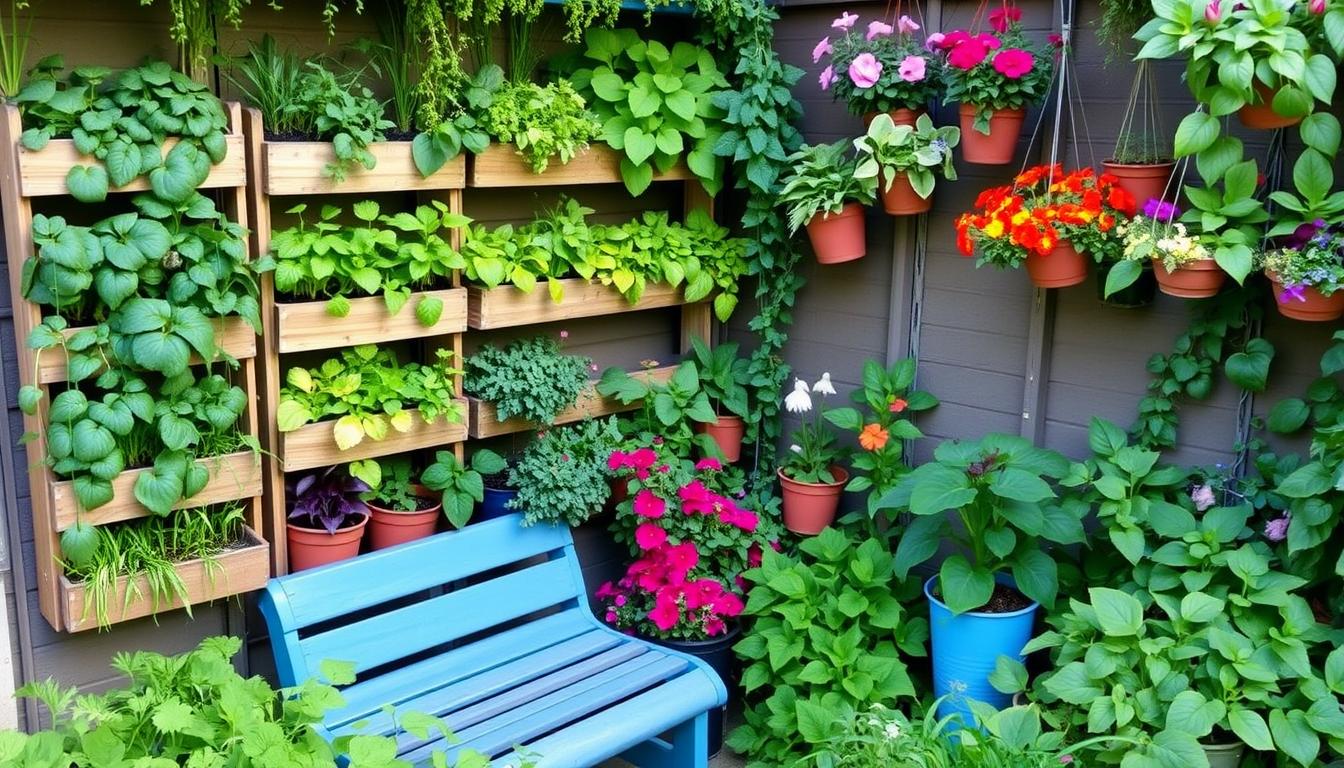1. Vertical Garden Layout
Thank you for reading this post, don’t forget to subscribe!Best For: Balconies, patios, or very small yards.
Key Features:
Vertical Planters: Use wall-mounted planters, ladder shelves, or tiered stacking pots.
Climbing Plants: Include trellises for vining crops like beans, peas, or cucumbers.
Hanging Baskets: Grow strawberries, cherry tomatoes, or herbs in hanging planters.
Pollinator Corner: Add a small bee hotel or hanging flower pots for pollinators.
Example Arrangement:
Back wall: Trellis with climbing vegetables.
Mid-level: Shelves for potted herbs or greens.
Top: Hanging baskets with cascading plants (e.g., strawberries).
Floor: A couple of larger pots for root vegetables or dwarf fruit trees.

2. Raised Bed Garden Layout
Best For: Urban backyards or shared spaces.
Key Features:
Compact Raised Beds: Use 2–3 small raised beds (3’ x 3’ or 4’ x 4’) to maximize planting space.
Interplanting: Combine fast-growers like radishes with slower crops like carrots to save space.
Companion Planting: Pair plants that grow well together, such as tomatoes with basil or marigolds.
Example Arrangement:
Bed 1: Salad crops (lettuce, spinach, radishes).
Bed 2: Root vegetables (carrots, beets) and herbs (chives, parsley).
Bed 3: One trellis for peas or beans; companion flowers like nasturtiums.

3. Container Garden Layout
Best For: Renters or paved surfaces.
Key Features:
Mobile Planters: Use pots and containers with wheels for flexibility.
Multi-Use Containers: Grow potatoes in deep buckets, herbs in small pots, and leafy greens in shallow trays.
Focus Zones: Group plants by sunlight needs or watering schedules.
Example Arrangement:
Sunny area: Containers with tomatoes, peppers, and basil.
Partial shade: Leafy greens like kale or lettuce.
Decorative zone: Flower pots for pollinators.

4. Square-Foot Gardening Layout
Best For: Small yards or highly organized gardeners.
Key Features:
Divide into Squares: Use a 4’ x 4’ grid (16 squares) for efficient planting.
Maximizing Yield: Plant one type of crop per square foot based on spacing guidelines.
Crop Rotation: Keep track of what you plant to rotate crops each season.
Example Arrangement (Each square foot):
2 squares: Tomatoes and marigolds.
2 squares: Carrots and radishes.
2 squares: Salad greens and spinach.
2 squares: Beans with a small trellis.
Rest: Herbs like basil, thyme, or cilantro.

5. Companion Planting Patch
Best For: Beginners who want low-maintenance gardens.
Key Features:
Companion Plants: Group crops that support each other (e.g., the “Three Sisters” method with corn, beans, and squash).
Layering Heights: Use tall plants to shade smaller ones.
Edible Flowers: Add flowers like nasturtiums or calendula for aesthetics and pest control.
Example Arrangement:
Center: Tall plants like sunflowers or corn.
Surrounding: Medium plants like bush beans or tomatoes.
Outer edge: Low-growing crops like lettuce or marigolds.

6. Herb Spiral Layout
Best For: Small spaces with uneven ground.
Key Features:
Spiral Design: Build a raised spiral with rocks or bricks, planting herbs with different needs at various heights.
Efficient Watering: Moisture-loving plants (e.g., mint) go at the base, and drought-tolerant ones (e.g., rosemary) at the top.
Example Planting:
Top: Rosemary, thyme, oregano.
Middle: Basil, parsley, cilantro.
Bottom: Mint, chives, lemon balm.

7. Mixed Use Garden with Animals
Best For: Urban homesteaders with small animals (e.g., chickens, rabbits).
Key Features:
Dual Zones: Divide space into animal and planting areas.
Chicken Run Edge: Use chicken-friendly plants like comfrey or sunflowers along the run.
Compost Integration: Place compost near the garden for easy fertilization.
Example Arrangement:
One side: Small chicken coop or rabbit hutch with a run.
Opposite side: Garden beds with vegetables and herbs.
Middle: Pollinator flowers or a small seating area.



